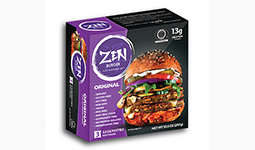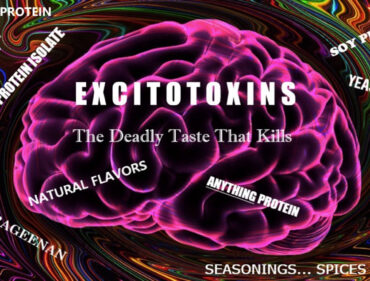D-Glutamate = Isolated Soy/Pea Proteins = Excitotoxins (neurotoxins)
http://www.truthinlabeling.org/manufac.html
On the Subject of Manufactured vs Natural Glutamic Acid
OVERVIEW – There are a number of straightforward bold faced lies used by the glutamate and food industry in defending its contention that exposure to free glutamic acid found in processed food does not cause adverse reactions, could not possibly cause brain damage, learning disorders, or endocrine disturbances; and could not possibly be relevant to diverse diseases of the central nervous system such as addiction, stroke, epilepsy, schizophrenia, anxiety, depression, and degenerative disorders such as ALS, Parkinson’s disease, and Alzheimer’s disease.
Central to their argument is the lie that the processed free glutamic acid used in processed food is identical to the glutamic acid found in unprocessed, unadulterated food and in the human body.
Our health sovereignty begins by isolated these protein myths from truth.
The truth of the matter is that the glutamic acid found in unprocessed, unadulterated, and/or unfermented food and in the human body is composed of one form of a single amino acid, L-glutamic acid, and nothing more. In contrast, the glutamic acid that is freed from protein through a manufacturing process or through fermentation (i.e., processed free glutamic acid), is always accompanied by a variety of impurities and carcinogens — i.e., byproducts of manufacture. Thus, the glutamic acid that is isolated from pea, soy, and whey protein, or yeast extract, maltodextrin and other deceptive labeling for MSG, used as a flavor enhancers or to isolate proteins in processed food is always composed of D-glutamic acid and impurities that inevitably appear during fermentation or other modes of glutamic acid manufacture or extraction processing. In addition to the inevitable production of D-glutamic acid, impurities may include, but are not limited to, pyroglutamic acid, mono and dichloro propanols, and heterocyclic amines. Mono and dichloro propanols and heterocyclic amines are know carcionogens. The consequences of the interactions of these various chemicals with other chemicals and/or with the digestive processes are unknown.
What we do know is that our bodies are organic living bio-systems that were ONLY designed to be nourished from real whole food ingredients that come directly from mama earth and our sun’s photosynthesis, free of pesticides, chemicals and other toxins.
Our bodies cannot recognize or assimilate these man-made ingredients, which puts our bodies in a stressed and highly inflammatory response.
Make no mistake. Since processed free glutamic acid (MSG) used in processed food and in plant “growth enhancers” is not identical to glutamic acid found in unprocessed, unadulterated food and in the human body, there is no reason to believe that the product called “glutamic acid” produced from these highly-processed protein extractions or by the glutamate industry will be functionally equivalent to pure L-glutamic acid.
Neuroscientists now know that these isolated proteins create excitotoxic effects that cause a number of dis-eased reactions in our bodies.
Closely associated with this boldfaced lie are a number of deceptive statements. The first states that all glutamic acid is metabolized identically. From that statement, the reader might be encouraged to conclude that processed free glutamic acid (MSG) and the L-glutamic acid found in unprocessed, unadulterated, unfermented protein are metabolized identically. The truth of the matter is that while the L-glutamic acid portion of processed free glutamic acid (MSG), and the L-glutamic acid found in unadulterated protein may be metabolized identically, metabolism of processed free glutamic acid (MSG) cannot be disassociated from metabolism of all of the impurities associated with processed free glutamic acid (MSG). The fact that L-glutamic acid found in unprocessed, unadulterated, unfermented protein and L-glutamic acid bound in processed free glutamic acid are metabolized identically becomes irrelevant.
There is also the issue of amino acid balance. Metabolism of amino acids, regardless of the source from which they come, is followed by uptake of those amino acids by the body’s amino acid transport system. One might think of individual amino acids waiting at the side of a river of blood for “vehicles” that will transport them to parts of the body where they will be put to work. However, the “vehicles” on which the various amino acids are transported out of the stomach and intestines have a limited capacity. So when unusually or relatively large amounts of one or a small group of amino acids present themselves for transport, there will be competition for the available space, and not all of the amino acids will be accommodated. The possible deleterious effects of this phenomenon, including too much of one amino acid or too little of another, have been ignored by the proponents of the safety of processed free glutamic acid (MSG).
Deceptive, also, is the often-repeated excuse that both processed free glutamic acid (MSG) itself, and the components of processed free glutamic acid (MSG) are “naturally occurring.” By FDA definition, any ingredient or constituent of an ingredient that comes from a plant or animal source is “naturally occurring.” Thus, arsenic and hydrochloric acid are both naturally occurring. You will not, however, find them used as food ingredients. Similarly, hydrochloric acid in the human body is essential to normal body function. We don’t, however, ingest hydrochloric acid.
Then there is the claim that “just a little won’t hurt anyone.” Yet, in truth, a little arsenic will, over time, harm people. The peanut residue left on a knife that had been wiped “clean” with a paper towel was enough to kill a child who was allergic to peanuts. The corn starch or maltodextrin used as binders and fillers in some vitamins, minerals, and medications will cause MSG reactions in acutely MSG-sensitive people. Indeed, no study to determine the least amount of processed free glutamic acid (MSG) needed to trigger an MSG reaction in MSG-sensitive people has ever been done.
Again. Any small amounts of free glutamic acid that might be found in unprocessed, unadulterated, and/or unfermented, food will be L-glutamic acid, only, and will not typically cause adverse reactions. This should not be confused with the glutamic acid that occurs in or on food as a consequence of manufacture or fermentation, which whether you are MSG-sensitive and immediately react to the ingestion of these isolated proteins or ingredients, make no mistake these ingredients are excitotoxins and highly toxic for our bodies. The fact that there may be some unadulterated, unfermented free glutamic acid in processed food or in produce is irrelevant to the fact that the manufacturing and extraction processes of isolated proteins and flavor enhancers product free D-glutamic acid and other known carcinogens.
GLUTAMIC ACID (often referred to as glutamate) is an amino acid found in all protein. Following ingestion of protein, and during the course of normal digestion, glutamic acid is released from ingested protein, becoming “free glutamic acid.” If sufficient amounts of free glutamic acid are not available for normal body function, the body can create glutamic acid from other amino acids. Humans do not need to eat glutamic acid or eat protein that contains glutamic acid in order to supply the body with the glutamic acid that it needs. For that reason, glutamic acid is referred to as a “non-essential” amino acid.
Because humans do not need to eat glutamic acid in order to supply the body with the glutamic acid that it needs, glutamic acid is called a “nonessential” amino acid.
Glutamic acid can also be freed from protein by fermentation, enzymolysis, use of acids, or other manufacturing extraction/isolation processes, prior to ingestion.
FREE GLUTAMIC ACID is glutamic acid that has been released from protein. Just as humans have two hands, glutamic acid has two enantiomers (chemically identical molecules with the L-enantiomer being the mirror image of the D-enantiomer). Just like most other alpha-amino acids, glutamic acid contains a stereogenic center and exists as the L- and D-enantiomers.
“The word chiral, from the Greek word for hand, alludes to molecules that exist in mirror-image versions — right-handed or left-handed. Although they appear to be identical twins, chiral molecules are fundamentally different. One molecular twin cannot be substituted for the other because they are asymmetrical. The difference is comparable to asymmetry between your right and left hand: One is a mirror image of the other, but you cannot fit your right hand into a left-hand glove.”(1)
“Although it has been generally accepted that the free amino acids and proteins found in higher organisms are composed exclusively of the L-enantiomers of amino acids, the mirror image D-forms are known to be present in some naturally occurring peptide antibiotics and in the cell walls of bacteria.” (2)
NATURAL FREE GLUTAMIC ACID is glutamic acid that has been freed from ingested protein during digestion, or glutamic acid that has been transaminated (created) from other amino acids. It is also possible that there are some minute amounts of natural free glutamic acid associated with some intact, unadulterated, unprocessed, unfermented protein. NATURAL FREE GLUTAMIC ACID found in higher organisms is made of L-glutamic acid only. “Natural food protein, as well as protein in the human body, contains only L-forms of amino acids.” (3)
“Unlike amino acids derived from natural protein, which possess only the structure (S)-12, synthetic amino acids are composed of equal mixtures of (S)-12 and (R)-12.” (4) Note: In this paper, (S)-12 refers to the L-amino acids and (R)-12 refers to the D-amino acids.
“There were contrasting views expressed on the use of the various isometric forms (the natural L-form or the commercially available mixtures of DL-forms) of amino acids.” (5)
“The chemical structure of L-glutamic acid and related compounds and the chemical composition of MSG are represented in Figure 1….Two possible stereoisomeric forms of glutamic acid exist, D and L. According to Maga (1983) the L form (dextrorotary form with the L-configuration) is the predominant natural form….” (6) (7)
“Because D-amino acids are rare in higher animals…” (8)
MANUFACTURED FREE GLUTAMIC ACID (MSG) is glutamic acid that has been freed from protein through a manufacturing process or fermentation prior to ingestion, or glutamic acid that has been grown from selected bacteria that secrete glutamic acid through their cell walls. There are over 40 ingredients in which MSG will be found. “Monosodium glutamate,” “autolyzed yeast,” and “natural flavoring” are names of some of those ingredients. (In the first FDA classification of such ingredients, the FDA called them “monosodium glutamate and other hydrolyzed proteins.”) The amount of free glutamic acid (MSG) that will be found in each is dependent on the method used to produce it, the protein source used (if bacterial fermentation was not used), and the extent of the processing.
MANUFACTURED FREE GLUTAMIC ACID is made up of L-glutamic acid and D-glutamic acid, and may bring with it pyroglutamic acid, mono and dichloro propanols (which are carcinogenic), heterocyclic amines (which are carcinogenic), and other unwanted byproducts (impurities).
“Foods contain a large assortment of xenobiotics (foreign, unnatural substances) that can have both positive and negative nutritional implications. One example is the occurrence of the uncommon D-stereoisomers of amino acids in some dietary proteins. These D-amino acids are produced from the common L-stereoisomers during food preparation and processing.” (9)
In table 1 of a research report by Rundlett and Armstrong, the authors present a list of all of the processed foods analyzed by them for L and D-glutamate (glutamic acid) content. Every one of the 38 processed foods evaluated contained D-glutamate. Three of those analyzed and found to have D-glutamate content were three brands of monosodium glutamate, including Ac’cent Flavor Enhancer, once marketed by Pet Incorporated. (10)
“Hydrolysis of proteins in 6 N HCl at 110 degrees centigrade for 24 h inevitably causes racemization of amino acids….Even under milder conditions of hydrolysis using lower temperatures and shorter exposure time, racemization of amino acids occurs.” (11)”Savory ingredients like hydrolyzed and isolated vegetable protein… have…been produced by…. extreme conditions…. [that] promote a variety of chemical reactions, thus a range of unwanted carcinogenic and impure by-products are produced as well.” (12)
“The chemical hydrolysis with hydrochloric acid is efficient, but almost any organic substance in the raw material is hydrolyzed, resulting in desired reactions such as hydrolysis of proteins, carbohydrates, fats (triglycerides), and the unwanted formation of mono and dichloro propanols (MCP and DCP).” (12)
“Pyroglutamic acid…occurs as a breakdown product of glutamate that can accumulate in foods during storage and processing.” (13)
“I have been asked to give testimony on the chemical nature of glutamates in food. The parent compound in the glutamate family is glutamic acid, an amino acid and normal component of the human body….Glutamic acid exists in two forms: (L)-glutamic acid and (D)-glutamic acid. The L and D designations indicate different spatial arrangements of the atoms of the two forms. (D)- and (L)- glutamic acid molecules are mirror images, relating to each other in the same way as a glove for the right hand relates to its mate for the left hand. Just as certain properties of the left-hand glove differ from those of the right-hand glove (e.g., the left-hand glove cannot be worn on the right hand, and vice versa), so (L)-glutamic acid and (D)-glutamic acid differ from each other in certain other properties. For example, in the body, (D)-glutamic acid is not broken down (metabolized) in the same way as the (L) form because the enzymes that recognize and work on the (L) form do not recognize, and, therefore, ‘ignore,’ the (D) form. Nearly all naturally occurring glutamic acid is in the (L) form.” (14)
REFERENCES
1. Bruce V. Bigelow, staff writer, San Diego Union-Tribune. October 4, 1995. (Source K. Barry Sharpless)
2. Rundlett, K.L. and Armstrong, D.W.. Evaluation of free D-glutamate in processed foods. Chirality. 1994;6:277-282.
3. Hunter, B.T. The Great Nutrition Robbery. New York, NY: Charles Scribner’s Sons, 1978, page 135.
4. Cram, D.J. and Cram, J.M. Host-Guest Chemistry: Complexes between organic compounds simulate the substrate selectivity of enzymes. Science. 1974;183:803-809.
5. Federal Register. Vol 38, No. 143–Thursday, July 26, 1973, page 20037
6. Maga, J.A.. Flavor potentiators. Critical Rev. Food Sci. Nutr. 1983;18:231-312.
7. Life Sciences Research Office of the Federation of American Societies for Experimental Biology. Analysis of adverse reactions to monosodium glutamate (MSG). July, 1995. Prepared for the Center for Food Safety and Applied Nutrition, Food and Drug Administration. Page 9.
8. Konno, R. et al. Origin of D-alanine present in urine of mutant mice lacking D-amino-acid oxidase activity. American Journal of Physiology, 1993, 265:G699-703.
9. Man, E.H. and Bada, J.L. Dietary D-Amino Acids. Ann. Rev. Nutr. 1987;7:209-25.
10. Rundlett, K.L. and Armstrong, D.W. Evaluation of free D-glutamate in processed foods. Chirality. 1994;6:277-282.
11. Konno, R. et al. Origin of D-alanine present in urine of mutant mice lacking D-amino-acid oxidase activity. American Journal of Physiology, 1993, 265:G699-703.
12. Pommer, K. (Novo Nordisk BioChem Inc., Franklinton, NC) Cereal Foods World. October, 1995 Vol 40. No 10. Page 745.
13. Life Sciences Research Office of the Federation of American Societies for Experimental Biology. Analysis of adverse reactions to monosodium glutamate (MSG). July, 1995. Prepared for the Center for Food Safety and Applied Nutrition, Food and Drug Administration. Page 31.
14. Expert Report of Paul M. Kuznesof, Ph.D., Chief of the Chemistry Review Branch in the Division of Product Manufacture and Use, Office of Premarket Approval, Center for Food Safety and Applied Nutrition, FDA. The Report was submitted on September 3, 1996 to the Federal Court in the Eastern District of Missouri re: Truth in Labeling Campaign, et al., vs. Shalala et al., pages 1-3.
http://www.truthinlabeling.org/III.What%20is%20MSG.html
How do truly natural glutamic acid and manufactured glutamic acid (MSG) differ?
Glutamic acid is an amino acid found in abundance in both plant and animal protein. In humans it is a non-essential amino acid, i.e., the body is capable of producing its own glutamic acid, and is not dependent upon getting glutamic acid from ingested food.
Glutamate is glutamic acid to which a mineral ion has been attached. (Researchers call this mineral ion a “salt”.) If the mineral ion is sodium, the glutamic acid becomes sodium glutamate. If the mineral ion is potassium, the glutamic acid becomes potassium glutamate.
In addition to its role as a building block of protein, glutamic acid serves as a neurotransmitter vital to the transmission of nerve impulses in many parts of the central nervous system. Under certain circumstances, glutamic acid becomes a neurotoxin, causing neuron degeneration and cell death which may be followed by neuroendocrine disorders.
When protein is digested, the glutamic acid in that protein is released for use in the body. If there is need, additional glutamic acid can be synthesized from other amino acids contained in ingested protein. If an individual never ingested protein with glutamic acid in it, that individual could synthesize all the glutamic acid needed for body function from other amino acids. The human brain is also capable of synthesizing glutamic acid according to its metabolic needs, from endogenous materials. Glutamic acid is referred to as a non-essential amino acid because a healthy human can manufacture/synthesize all the glutamic acid needed for normal body function from other amino acids.
What is MSG?
MSG is glutamic acid that has been produced outside of the human (or animal) body. But when glutamic acid is produced or created in this way (outside of the human body), it differs significantly from the glutamic acid found in unadulterated, unprocessed, unfermented protein or released from unadulterated, unprocessed, unfermented protein during digestion. Glutamic acid found normally in the human body (and in all higher organisms) is glutamic acid in the L form, i.e., L-glutamic acid. Glutamic acid that is produced outside of the human body is made up of L-glutamic acid and an array of unwanted by-products often referred to as impurities. L-glutamic acid produced outside of the human body is always accompanied by impurities such as D-glutamic acid and pyroglutamic acid; and when L-glutamic acid is produced by way of acid hydrolysis, carcinogenic mono and dichloro propanols inevitably accompany it.
All manufactured free amino acids are accompanied by impurities. The fact that glutamate produced outside of the human body is categorized as food grade or pharmaceutical grade (99% pure) attests to the fact that impurities always accompany amino acids produced outside the body.
MSG fed to the very young has been shown to cause brain damage and subsequent learning, behavior, and endocrine disorders such as reproductive disorders and gross obesity. Ingestion of MSG and the D-glutamate acids carries impurities that accompany manufactured isolated proteins and flavor enhancers by people of all ages will cause adverse neurotoxic reactions. Eating protein (which will contain bound glutamic acid that is L-glutamic acid, only) does not cause either brain damage or adverse reactions.
Additional information, including relevant citations, can be found at:
On the Subject of Manufactured vs Natural Glutamic Acid,
Evidence of MSG-induced Brain Damage and Endocrine Disorders: The Animal Studies,
Evidence of MSG-induced Human Adverse Reactions: The Human Studies, and
The Young are Particularly at Risk for Brain Damage from Ingestion of MSG: Data
http://naturallysavvy.com/eat/taking-the-mystery-out-of-natural-flavors
















